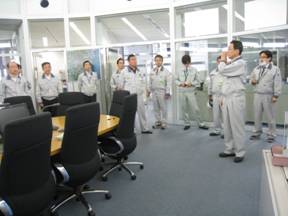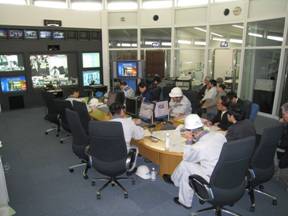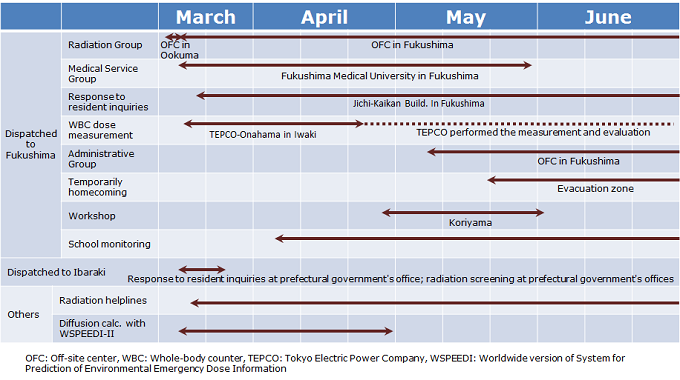The NEAT, as a designated public institution, is on duty to respond to nuclear emergencies at nuclear facilities and to receive notifications and requests for assistance from the government.
When an emergency call is received by the duty manager, the contents of the call are promptly reported in accordance with the communication system (telephone, facsimile, e-mail, etc.) based on the support system, and a series of tasks are carried out, such as convening full-time personnel and designated experts through the emergency call-out system, and starting up the emergency support system(TV conference system, information database system, information sharing system for emergency management, etc.), in order to establish a rapid human and technical support activity system for the initial response. We also collect information by receiving emergency information e-mails and information e-mails distributed by the Nuclear Regulatory Commission in the event of a defined event. A nuclear emergency is classified into an Notification Of Unusual Events(NOUE), an Alert, a Site area Emergency(SE), and a General Emergency(GE). In FY 2023, there were two Alert and two NOUE incidents, as follows. We took initial actions on these issues.
| date | event |
|---|---|
| January. 1, 2024 | [Alert] an earthquake with an intensity of 7 in Shika town by the earthquake the Ishikawa prefecture Noto Peninsula. |
| January. 6, 2024 | [Alert] an earthquake with an intensity of lower 6 in Shika town by the earthquake the Ishikawa prefecture Noto Peninsula. |
| January. 16, 2024 | [Notification Of Unusual Events] an earthquake with an intensity of lower 5 in Shika town by the earthquake the Ishikawa prefecture Noto Peninsula. |
| Mar. 15, 2024 | [Notification Of Unusual Events] an earthquake with an intensity of lower 5 in Naraha town by the earthquake off the coast of Fukushima prefecture. |
After the press report in April 2012 that the impending of the 3rd North Korean underground nuclear test became highly probable, the JAEA/NEAT established a framework for responding to the crisis in cooperation with Nuclear Science and Engineering Directorate (NSED) of the JAEA. This framework was maintained around the clock for 11 months until March 2013.
From February 12 until February 22, 2013, which was said that the North Korea executed an underground nuclear test, the NEAT and NSED performed predictive calculations of atmospheric radioactive material dispersion within the area around Japan including the North Korea by using the WSPEEDI-II system. The predicted results were reported to the Ministry of Education, Culture, Sports, Science and Technology (MEXT). They were published at its website, and they were utilized for air sampling by the Ministry of Defense with aircrafts of the Japan Air-Self-Defense Force.
Details of our responses above was described in the report: "The Establishment of the Framework and Actual Experience for the Prediction of Atmospheric Dispersion of Radionuclides against the Nuclear Test by North Korea" (JAEA-Technology 2013-030) (in Japanese).
After the mission of responding to North Korean nuclear tests was transferred from the MEXT to the Nuclear Regulation Agency (NRA) in April 2013, the NRA established an operational framework of WSPEEDI-II system in the Nuclear Safety Technology Center (NUSTEC) by entrustment. In January 2016, for responding to the 4th execution of North Korean nuclear test, the NUSTEC performed predictive calculations of the atmospheric dispersion of radioactive materials by using the WSPEEDI-II system. After that, since the NRA terminated the entrustment to the NUSTEC, the NEAT restarted supporting the subsequent response to North Korean nuclear tests on the request of the NRA.
At the 5th execution of North Korean nuclear test in September 2016, and at the 6th execution in September 2017, the NEAT performed the predictive calculations of the atmospheric dispersion of radioactive materials by using the WSPEEDI-II system in cooperation with the Nuclear Science and Engineering Center (the former NSED). The predicted results were reported to the NRA, which was published on the website of the NRA every day, and they were utilized as well by the Ministry of Defense for air sampling with aircrafts of the Japan Air-Self-Defense Force.
Details of our responses at the 5th and the 6th North Korean nuclear tests and the summary of the calculation system and program used for the prediction of atmospheric dispersion of radioactive materials are described in the report: "Activities on predictions of atmospheric dispersion of radionuclides for nuclear tests by North Korea" (JAEA-Technology 2018-007) (in Japanese) ".
The NEAT has engaged in supportive activities against the accident at TEPCO's Fukushima Daiichi Nuclear Power Station in collaboration with major branches of the Japan Atomic Energy Agency (JAEA) since just after the occurrence of Tohoku Region Pacific Coast Earthquake on March 11 in 2011. The earthquake hit also Ibaraki Prefecture where the JAEA/NEAT was located, therefore, the above activities had to be performed in the damage accompanied by the earthquake and tsunami.


Activity status at the room for information consolidation
The NEAT engaged in various activities such as dispatching staff and materials, giving technical supports, etc. An outline of the NEAT activities, their duration and location are summarized in the tablebelow:

We have various special vehicles, which were dispatched to Fukusima Prefecture, within Ibaraki Prefecture and to other districts. The record of their dispatch is shown in the table below:

The details are given in a separate web page and in a Japanese report: JAEA-Review 2011-049.